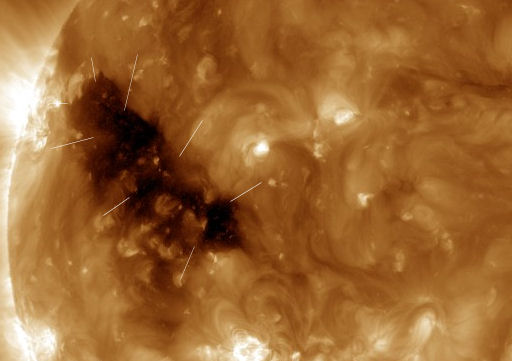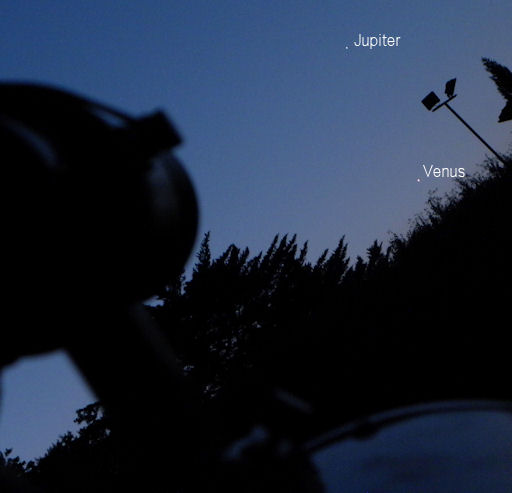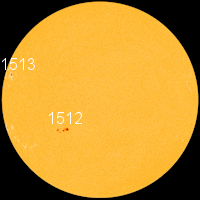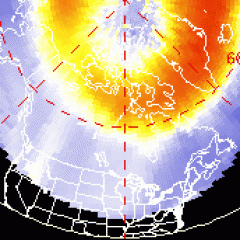NOCTILUCENT CLOUDS: For the third day in a row, observers in Europe are reporting bright displays of electric-blue noctilucent clouds. Check the NLC Photo gallery for the latest sightings.
CORONAL HOLE: Spewing a stream of high-speed solar wind, a dark gap in the sun's atmosphere is turning toward Earth. NASA's Solar Dynamics Observatory photographed the coronal hole during the early hours of June 27th:
Coronal holes are places where the sun's magnetic field opens up and allows solar wind to escape. A stream of solar wind flowing from this particular opening should reach Earth on July 1-2. High-latitude sky watchers should be alert for auroras on those dates. Magnetic storm alerts: text, voice.
MORNING SKY SHOW: Set your alarm for dawn. Venus and Jupiter are converging in the morning sky, setting the stage for a beautiful three-way conjunction with the crescent Moon in July. This morning, Giuseppe Petricca photographed the bright planets shining in the east over Pisa, Italy:
"What a wonderful morning," says Petricca. "Jupiter appeared first, bright and low on the horizon. Through the telescope we could clearly see bands on the planet. Venus arrived shortly thereafter."
Here are some key dates in July:
On July 4th, Venus will pass dead-center through the Hyades cluster, a loose grouping of stars 153 light years from Earth. The temporary addition of Venus will make it seem that a supernova has gone off in the cluster.
Three mornings later, on July 7th, Venus and Jupiter line up with Aldebaran, the bright red eye of Taurus the Bull. Aldebaran is a red giant star of first magnitude. Together with the two planets, it forms an almost perfect vertical line in the brightening dawn sky.
On July 9th, Venus and Aldebaran converge to form a planet-star pair of surpassing beauty. Scarcely more than a degree of arc will separate the two celestial bodies as Jupiter looks down from overhead.
And then, on July 15th, a 12% crescent Moon joins the show, forming a bright celestial triangle with Venus and Jupiter.
Meanwhile, browse our Realtime Photo Gallery for more planet-shots.

![]()
Solar wind
speed: 415.8 km/sec
density: 5.4 protons/cm3
explanation | more data
Updated: Today at 1427 UT
![]()
X-ray Solar Flares
6-hr max: C3 1238 UT Jun27
24-hr: C3 1238 UT Jun27
explanation | more data
Updated: Today at: 1400 UT
![]()
![]()
![]()
Daily Sun: 27 Jun 12
![]()
![]()
Sunspot 1512 poses a growing threat for M-class solar flares. Credit: SDO/HMI
![]()
![]()
![]()
Sunspot number: 28
What is the sunspot number?
Updated 27 Jun 2012
Spotless Days
Current Stretch: 0 days
2012 total: 0 days (0%)
2011 total: 2 days (<1%)
2010 total: 51 days (14%)
2009 total: 260 days (71%)
Since 2004: 821 days
Typical Solar Min: 486 days
Updated 27 Jun 2012
The Radio Sun
10.7 cm flux: 99 sfu
explanation | more data
Updated 27 Jun 2012
![]()
![]()
![]()
Current Auroral Oval:
![]()
Switch to: Europe, USA, New Zealand, Antarctica
Credit: NOAA/POES
![]()
![]()
![]()
Planetary K-index
Now: Kp= 1 quiet
24-hr max: Kp= 2 quiet
explanation | more data
![]()
Interplanetary Mag. Field
Btotal: 6.2 nT
Bz: 3.8 nT south
explanation | more data
Updated: Today at 1427 UT
![]()
![]()
![]()
Coronal Holes: 27 Jun 12
![]()
![]()
Solar wind flowing from this coronal hole should reach Earth on July 1-2. Credit: SDO/AIA.






